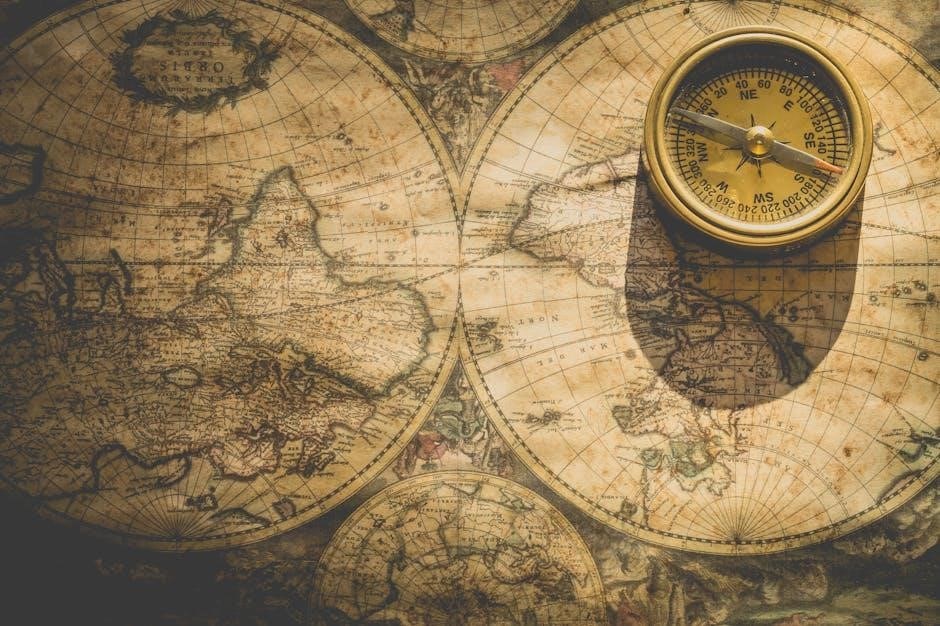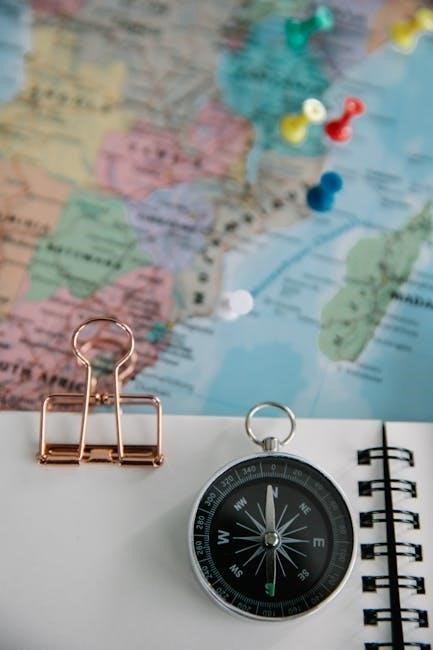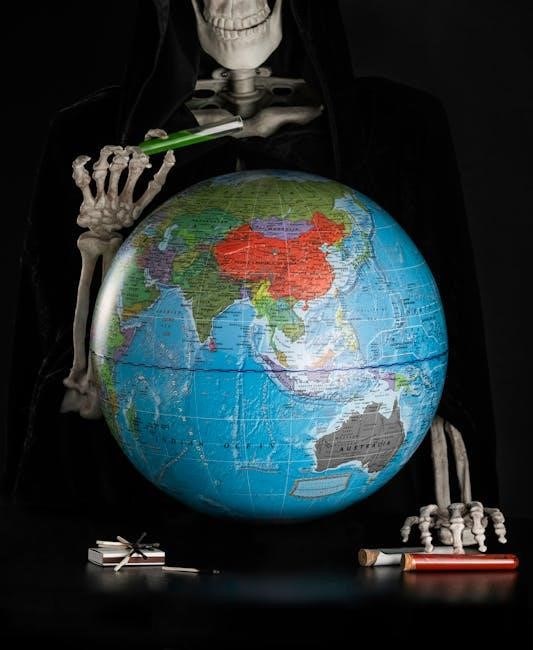The concept of parallel worlds introduces alternate realities where individuals like Hidako Masamune, a bullied NEET, find redemption through extraordinary circumstances and unique abilities.
Understanding the Idea of Parallel Worlds
The concept of parallel worlds suggests the existence of alternate realities, where events unfold differently from our own. In A NEET’s Guide to the Parallel World, this idea is explored through Hidako Masamune’s journey. After attempting suicide, Masamune is transported to a parallel world with his classmates, where they are assigned unique abilities. This new reality offers a fresh start, challenging their perceptions of strength and purpose. The parallel world concept serves as a backdrop for themes of redemption and growth, highlighting how alternate realities can transform lives and redefine one’s role in the universe.
The Role of NEETs in Exploring Alternate Realities
NEETs, individuals often disconnected from society, play a pivotal role in exploring alternate realities. In A NEET’s Guide to the Parallel World, Hidako Masamune exemplifies this transformation. Despite being bullied and marginalized, he discovers newfound purpose in a parallel world. His journey highlights how NEETs, often overlooked in their own reality, become central figures in navigating alternate dimensions. Their unique perspectives and experiences equip them to adapt and thrive in these new environments, challenging societal norms and proving their potential. This concept underscores the idea that even those on the fringes of society can become key players in extraordinary realms.

The Protagonist’s Journey
The protagonist’s journey in A NEET’s Guide to the Parallel World is a transformative quest of self-discovery, resilience, and growth, reshaping their identity and purpose.
Hidako Masamune: A NEET’s Struggle with Bullying
Hidako Masamune, a young NEET, endures brutal bullying at school, leading to social isolation and a deep sense of hopelessness. His peers mercilessly taunt him, while teachers remain indifferent, worsening his suffering. The relentless harassment erodes his self-esteem, pushing him into a spiral of depression and loneliness. Unable to cope, Hidako becomes withdrawn, feeling trapped in a world that rejects him; His struggles highlight the harsh realities many NEETs face, often overlooked by society. This torment ultimately drives him to contemplate drastic measures, setting the stage for his life-altering decision to escape his painful existence.
The Decision to Commit Suicide and Its Consequences
Overwhelmed by despair, Hidako Masamune reaches a breaking point, deciding to end his life to escape unrelenting suffering. His suicide attempt fails, but the act serves as a catalyst for his transportation to a parallel world. This unexpected twist transforms his fate, offering a second chance far removed from his previous torment. The consequences of his decision unfold as he enters a realm where his past trauma becomes the foundation for newfound purpose. This pivotal moment marks the beginning of his journey from victimhood to self-discovery, reshaping his identity in ways he could never have imagined.
Transportation to the Parallel World
Following his failed suicide attempt, Hidako is enveloped by a mysterious, blinding light that disrupts his consciousness. He feels an intense sensation of being pulled through a vortex, leaving his old world behind. Upon opening his eyes, he finds himself in a completely unfamiliar environment, marking his arrival in the parallel world. The transition is abrupt and disorienting, leaving him stunned and confused. This unexpected transportation sets the stage for his new journey, shifting his perspective from despair to cautious curiosity about the possibilities this new realm holds.

Arrival in the Parallel World
Hidako finds himself in a realm vastly different from his own, surrounded by unfamiliar landscapes and strange creatures. Disoriented, he struggles to grasp this new reality.
First Impressions of the New Environment
The parallel world unfolds as a breathtaking yet unsettling realm, with shimmering skies and landscapes unlike anything Hidako has ever seen. Towering forests and glowing flora surround him, creating an otherworldly atmosphere. The air carries an unfamiliar energy, and strange creatures flit at the edges of his vision. Initially, awe and confusion dominate his emotions, but fear lingers as he grapples with the reality of his new surroundings. The environment feels alive, as if it responds to his presence, adding to the surreal experience. For a NEET accustomed to isolation, this vibrant world is both overwhelming and intriguing, offering a stark contrast to his mundane past life;
The Assignment of Unique Abilities
Upon arrival, each individual is granted unique abilities tailored to their latent potential. A mysterious ceremony or test determines one’s powers, ranging from elemental manipulation to healing or enhanced physical traits. These abilities are tied to the world’s energy, making them integral to survival and growth. While some receive formidable powers, others, like Hidako, are assigned roles deemed less glamorous, such as healing. Despite initial disappointment, these abilities often hold hidden strengths and versatility. The assignment process is seemingly random, yet it reflects the world’s need for balance, ensuring diversity in skills. This system fosters both competition and collaboration, shaping the NEET’s journey in unexpected ways.
The Class System and Initial Dismissal of the Healer
The parallel world operates under a strict class system, where individuals are categorized based on their assigned abilities. Warriors, mages, and other combat-oriented classes are highly valued, while healers are often overlooked. The healer class, despite its importance, is frequently dismissed as weak or less capable. This bias stems from the world’s focus on power and combat prowess. Many view healers as secondary supporters rather than essential contributors. Hidako, assigned as a healer, faces initial discrimination and skepticism from peers, further isolating him. This societal undervaluing of healers highlights the world’s flawed priorities, setting the stage for Hidako’s eventual proving of their worth.

The Healer Class
The healer class, often misunderstood, specializes in restoration and support, playing a crucial role in sustaining allies. Its unique abilities focus on health replenishment and status effects, offering indirect yet vital contributions to combat and exploration. Despite its importance, the class is frequently underestimated, with many viewing it as less impactful than offensive roles. However, healers possess hidden strengths, such as enhanced survivability and the ability to bolster team performance, making them indispensable in the parallel world’s challenges.
Perceived Weaknesses and Initial Challenges
The healer class is often seen as weak due to its lack of offensive capabilities, making it a target for dismissal. Many view healers as inferior, believing their role is less impactful compared to damage-dealing classes. Initially, the protagonist struggles with this perception, feeling overshadowed and undervalued. The class’s limitations in direct combat and reliance on support abilities create doubts about its usefulness. Additionally, the societal bias in the parallel world against non-combat roles further marginalizes healers, adding to the protagonist’s challenges. This widespread misunderstanding pushes the healer to prove their worth, highlighting the need for growth and recognition in a world that prioritizes strength over support.
Discovering Hidden Strengths and Capabilities
As the protagonist delves deeper into the parallel world, they uncover the healer class’s untapped potential. Unique abilities, such as enhanced sensory perception and resistance to negative effects, begin to emerge. These traits, initially overlooked, prove invaluable in specific scenarios, showcasing the class’s versatility. The healer’s ability to sustain allies and adapt to diverse challenges highlights their critical role in teamwork. Through experimentation and adversity, the protagonist learns to harness these hidden strengths, transforming perceived weaknesses into strategic advantages. This discovery not only redefines their self-perception but also challenges societal norms, proving that even the most underestimated roles can hold extraordinary power.
Overcoming Limitations Through Growth
The protagonist’s journey in the parallel world is marked by steady growth, as they gradually transcend the constraints of their initial circumstances. Through perseverance and self-reflection, they develop resilience and resourcefulness, qualities that were dormant in their previous life. By embracing challenges and learning from setbacks, they refine their abilities and gain confidence. This transformation highlights the potential for personal evolution, even for those who feel trapped by their situation. The parallel world serves as a catalyst, pushing the protagonist to confront their fears and limitations head-on. Growth becomes a cornerstone of their survival and eventual success in this new reality.

Classmates in the Parallel World
The protagonist encounters diverse classmates, each with unique abilities and personalities. Initial skepticism towards the healer class gradually fades as they prove their worth in challenging situations.
Building Relationships and Trust
Forming connections in the parallel world is crucial for survival and growth. Initially, the healer class’s perceived weakness creates skepticism among classmates, making trust hard to earn. Over time, through consistent effort and demonstration of unique abilities, the protagonist gains respect and builds strong bonds. Shared challenges and collaborative efforts foster deeper relationships, proving that trust is a cornerstone of success in this new reality. The journey from isolation to camaraderie highlights the importance of perseverance and understanding in overcoming initial doubts and fostering a supportive community.
Collaboration and Teamwork in the New World
Collaboration becomes essential in the parallel world, where diverse abilities and strengths are vital for overcoming challenges. The healer class, though initially overlooked, proves indispensable by supporting teammates and enabling prolonged battles. Teamwork fosters a sense of unity, as classmates learn to rely on one another’s unique skills. Through shared struggles, they develop strategies that leverage their collective power, demonstrating that no single class can dominate alone; This synergy not only enhances combat effectiveness but also strengthens bonds, transforming former strangers into a cohesive unit capable of mastering the world’s complexities. Collaboration becomes the cornerstone of survival and success in this unforgiving yet rewarding environment.

Challenges in the Parallel World
Navigating the parallel world presents unforeseen challenges, including adapting to unfamiliar landscapes, deciphering new rules, and confronting enigmatic threats, all while relying on newfound abilities and alliances.
Adapting to a New Society and Its Rules

Adapting to the parallel world’s society requires mastering its unique customs, laws, and social hierarchies. NEETs must learn to navigate unfamiliar cultural norms, which may differ drastically from their original world. The society’s rules, often unwritten, can be puzzling, requiring careful observation and adaptation. Social interactions demand new strategies, as relationships are built on trust and mutual respect. Additionally, the NEET must contend with differing technological levels and resource availability, forcing them to rely on creativity and resilience. The psychological strain of feeling like an outsider is immense, but adapting becomes a crucial survival skill, fostering personal growth and integration into this new reality.
Facing Monsters and External Threats
In the parallel world, NEETs encounter a variety of monstrous creatures and external threats that test their survival skills. These threats range from mutated beasts to rogue magical entities, each requiring unique strategies to overcome. To survive, NEETs must learn to craft weapons, use their abilities effectively, and avoid dangerous zones. Understanding monster behavior and patterns is crucial, as some threats are nocturnal or triggered by specific actions. Forming alliances with other beings can provide additional protection, but trust must be earned. Constant vigilance and adaptability are essential, as the parallel world is unforgiving to the unprepared. Survival depends on quick thinking and resourcefulness.
Navigating the Political Landscape
Navigating the political landscape in the parallel world requires careful observation and strategic decision-making. NEETs must identify key factions, alliances, and rivalries that shape the world’s power dynamics. Understanding local leaders’ motivations and agendas is crucial, as missteps can lead to unintended conflicts. Building relationships with influential figures can provide protection and resources, but trust must be earned gradually. Political maneuvering often involves subtle diplomacy, and NEETs must avoid being manipulated by hidden agendas. The ability to remain neutral or strategically align with factions can greatly influence survival and success. Political awareness becomes a vital skill in this unpredictable environment.

Character Development
The protagonist undergoes significant transformation, evolving from a bullied NEET to a confident leader. Their journey of self-discovery, overcoming trauma, and forming meaningful connections drives profound personal growth.
From Victim to Leader: The Protagonist’s Growth
The protagonist’s journey from a bullied NEET to a confident leader is a testament to resilience and growth. Initially overwhelmed by past traumas, they gradually embrace their new role in the parallel world. Through self-discovery and overcoming challenges, they develop leadership qualities, inspiring others with their courage. Their transformation from a victim of circumstance to a guiding figure highlights the power of personal growth and the impact of a supportive environment. This evolution not only shapes their identity but also influences those around them, proving that even the most broken individuals can rise to become leaders.
Overcoming Psychological Trauma
The protagonist’s journey in the parallel world is deeply intertwined with healing from psychological trauma. Haunted by memories of bullying and isolation, they initially struggle to cope with their new reality. However, the challenges and responsibilities of the parallel world force them to confront their inner demons. Through supportive relationships and personal achievements, they gradually rebuild their self-esteem and confidence. The process is not linear, with setbacks and emotional struggles, but the protagonist learns to embrace their resilience. This transformation highlights the possibility of healing, even for those deeply scarred by their past experiences. Growth becomes a powerful tool for overcoming trauma.
Building a New Sense of Purpose
In the parallel world, the protagonist discovers a renewed sense of purpose by embracing their role as a healer. Initially, they feel lost and without direction, but their unique abilities and the reliance of others on them spark a transformation. By contributing to the well-being of their classmates and the community, they find meaning in their actions. This sense of responsibility evolves into a deeper understanding of their worth, shifting their identity from a NEET to a vital member of society. The parallel world offers a fresh canvas, allowing them to redefine their life’s purpose and create a legacy rooted in compassion and strength.

Themes and Lessons
The narrative explores themes of redemption, hope, and personal growth, offering insights into overcoming adversity and finding purpose, especially for those feeling displaced in society.
The Power of Hope and Redemption
The narrative emphasizes the transformative power of hope and redemption, particularly for NEETs who often feel marginalized. By immersing the protagonist in a parallel world, the story illustrates how hope can reignite purpose and drive personal transformation. Redemption is portrayed as a universal force, enabling individuals to overcome past traumas and societal stigma. The protagonist’s journey from despair to empowerment highlights the possibility of change, regardless of one’s circumstances. This theme resonates deeply, offering a message of renewal and the idea that redemption is within reach, even in the most unexpected realities.
The Importance of Relationships
In the parallel world, relationships play a pivotal role in shaping the protagonist’s journey. Forming bonds with classmates and allies fosters trust and collaboration, essential for survival and growth. These connections not only provide emotional support but also unlock new opportunities for teamwork and mutual understanding. By building strong relationships, the protagonist learns to navigate the complexities of the new society and gains a sense of belonging. This emphasis on interpersonal connections highlights the value of friendship and camaraderie, especially for NEETs, who often struggle with social isolation. Relationships become a cornerstone of strength, enabling personal growth and collective success in the parallel world.
Moral Lessons for the Modern NEET
The parallel world experience offers profound moral lessons for modern NEETs, emphasizing the importance of self-discovery and resilience. It highlights that life, even in its darkest moments, holds opportunities for redemption and growth. The protagonist’s journey teaches that one’s worth isn’t defined by societal labels or past failures. By embracing challenges and fostering empathy, NEETs can find purpose and belonging. The story underscores the value of perseverance, encouraging individuals to seek meaning even in unconventional paths. It also reminds us that kindness and understanding can transform lives, offering hope to those feeling lost or disconnected from society.
The NEET’s journey through the parallel world reveals profound lessons about courage, hope, and self-worth, inspiring others to embrace their unique paths and find purpose.
Final Thoughts on the NEET’s Journey
The NEET’s odyssey through the parallel world underscores a transformative tale of self-discovery and resilience. By overcoming adversity, the protagonist evolves from a marginalized individual to a beacon of hope, illustrating that even in the darkest corners, redemption is possible. This journey serves as a powerful metaphor for NEETs in the real world, encouraging them to seek purpose and embrace their unique potential. The parallel world’s lessons of hope, relationships, and personal growth resonate deeply, offering a roadmap for those feeling lost to find their place in society.

The Impact of the Parallel World Experience
The parallel world experience profoundly reshapes the NEET’s perspective, offering a fresh lens to view life’s challenges. By navigating an alternate reality, they gain invaluable insights into resilience, adaptability, and the true meaning of strength. The lessons learned—such as the importance of relationships and self-belief—become guiding principles in their real-world journey. This transformative experience fosters personal growth, enabling them to approach life with renewed confidence and purpose. The parallel world, once a refuge, becomes a catalyst for change, empowering the NEET to embrace opportunities and overcome limitations in both realms.
A Look into Future Possibilities
The parallel world experience opens doors to endless possibilities for the NEET. Having discovered their hidden strengths and forged meaningful connections, they are now equipped to face future challenges with confidence. In the parallel realm, they may explore uncharted territories, uncover new abilities, or even take on leadership roles. Back in their original world, the lessons learned could inspire positive change, helping them break free from societal expectations and carve their own path. The journey through the parallel world sparks a transformative mindset, paving the way for a brighter, more purposeful future in both realities.
